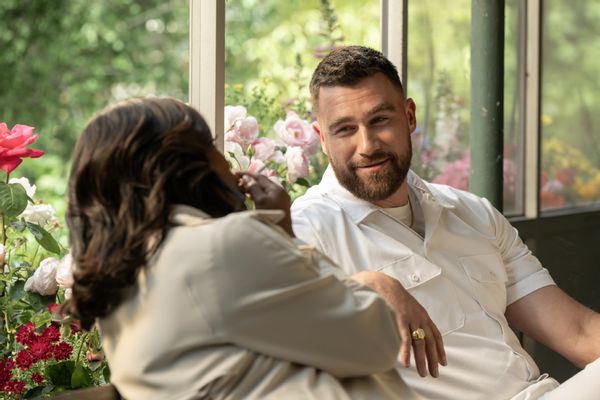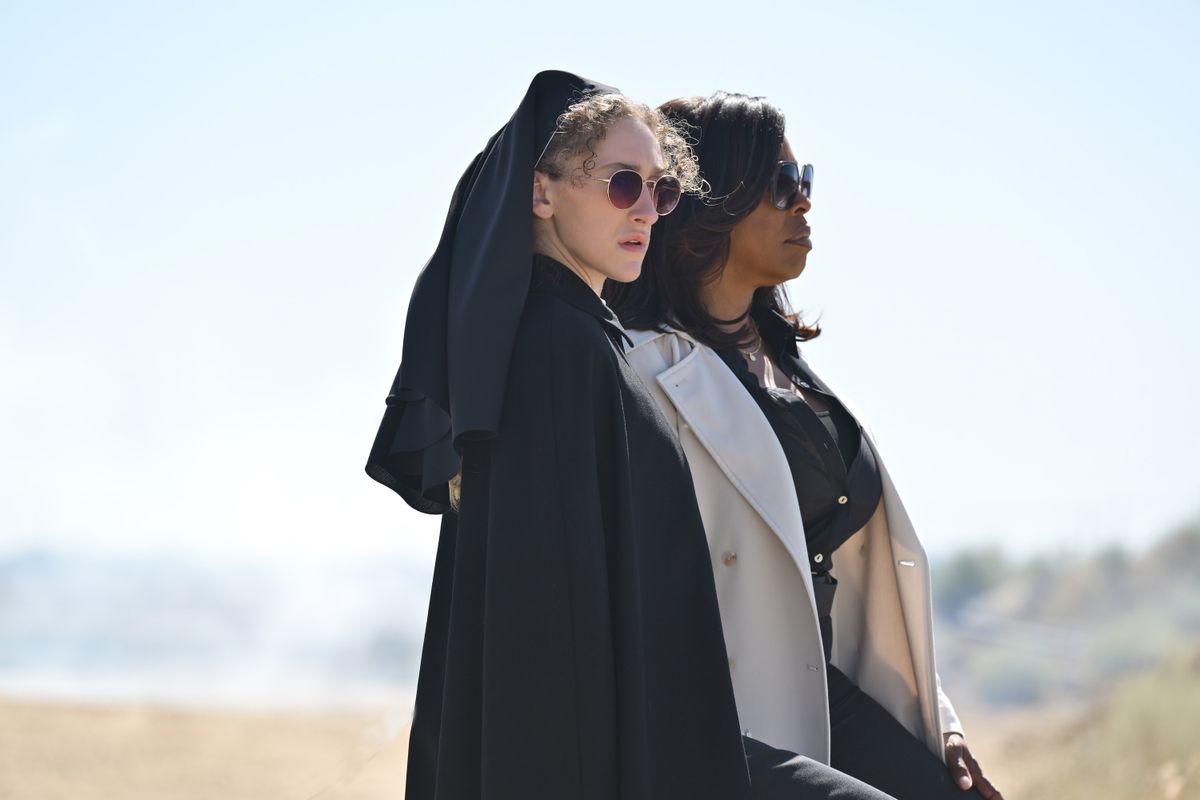If all horror is metaphor, then of course “Grotesquerie” would feature a turducken. The hedonistic holiday feast occasions Det. Lois Tryon (Niecy Nash-Betts) to drop the culinary term “engastrated,” which she explains to her daughter Merritt (Raven Goodwin) describes when the remains of one animal are stuffed inside of another animal – here, a chicken inside of a duck inside of a turkey, each separated by layers of andouille sausage stuffing.
The word lends a technical remove to a grisly concept unless you love food and haven’t seen the gore and entrails served up rare and glistening throughout the previous episode. Absent those images, watching Lois debone, stuff and truss up a turducken would be mouthwatering.
Subtlety has never been a Ryan Murphy signature, so not even the food porn in “Grotesquerie” offers a safe harbor.
The same episode that shows the corpse of a dead woman with what look like intestines coming out of her mouth features a tight shot of Lesley Manville’s manicured hand selecting a clean grape from a dish before the camera zooms in on her scarlet lips as she greedily masticates it.
A snug frame of a flower bed in full bloom is interrupted by vomit. People are reduced to meat and parts arranged in artistic displays reminiscent of Renaissance paintings. Carolina Costa’s unrelentingly intimate shots of viscera through the first three episodes refuse to allow us distance from these murders. Since we came for the shock value, the camera shoves our faces in its guts, bellowing to eat up.
Following all that, Lois’ gastronomical overkill, a gift from a mother who loves to drink and cook for a daughter who can’t control her food intake, is appropriately filmed to look like a maniac readying his disturbing masterpiece. What should be mouthwatering instead physicalizes this show’s defining descriptor: disgust.
There’s nothing in the first four episodes of “Grotesquerie” that other crime shows haven’t flirted with if not displayed outright. “Hannibal” broke that barrier a decade ago by using fetching cinematographic and sensual editing to make cannibalism look appetizing.
Even so, Murphy and his collaborators Jon Robin Baitz and Joe Baken use that bar to push onto the audience things we haven’t seen and yet can’t erase from memory, the vilest of which is never shown.
When Lois meets her eventual crime-solving partner Sister Megan (Micaela Diamond) she will only say, “Think about the worst thing you could never unsee, boiling in a pot.”
For the viewer, that guesswork is eliminated by the macabre tableau to which she’s referring. A mother and her two young children have been gruesomely killed, their bodies placed upright at a formal table laden with a hearty meal. What remains of the father is on the kitchen floor, and a cutting board – and yes, in front of his family.
And there is an empty highchair.
All this comes before a close-up on a suppurating bedsore.
Murphy’s work always tries to tease out a metanarrative about the American condition, whether the topic celebrates fame and glamor or is an indictment of our failings and excesses. Some are more successful than others, and it's too early to say whether “Grotesquerie” fits in the win column; the critical consensus is on the lower side of mixed. It’s easy to see why.
Lois is a walking TV trope made tolerable solely by the muscle and sinew of Nash-Betts’ performance: another gifted detective who has seen too much and self-medicates with gallons of vodka.
Sister Megan is a virginal bride of Christ, and a journalist with a morbid fascination with serial killers and crime scenes. The show’s title is also the killer’s moniker, reflecting his fascination with Biblical allusions in his baroque murder scenes Lois suspects are designed to taunt her.
Lois and Megan’s separate entanglements spell out the humanity behind symbolism. Merritt shares Lois’ addictive tendencies, but her vice is food. Lois is trapped in a marriage to a man (Courtney B. Vance) who cheated on her, and to whom she said horrid if understandable things before he fell into a coma.
Sister Megan finds a kindred spirit in Father Charlie (Nicholas Alexander Chavez), who, along with sporting a pompadour and the abs of Michelangelo’s David, has a kink for self-flagellation and leather chaps.
Initially, the two are drawn to each other through their shared weird hobby, giggling over diner burgers at the mischief of Ed Gein. Not long afterward, the good sister is turning on the priest by describing how Lois’ lurid crime scenes are displayed.
The opening episodes of “Grotesquerie” do little to reveal the moral bubbling beneath the obscenity. Murphy has dropped a few hints in interviews in saying he was inspired by the sinking feeling that the world is ending, sucked into the vortex of a death spiral between good and evil.
Four installments into its 10-episode season, however, “Grotesquerie” strains at the seams with concepts. It is a Ryan Murphy Troupe alumni showcase. It is a cop drama. But if it has any lasting value, that may rest in its role as a loathsome parable of America’s tortured obsession with human bodies, ground into a sausage of fear and religiosity. Despite its aggressive appearance, the “Grotesquerie” strain of cultural critique may be, if not nuanced, at least thought-provoking instead of merely provocative.
We need your help to stay independent
Murphy’s a frequent flyer in the political and social commentary class of series creators, having taken on Trumpism earlier than most via his “Cult” season of “American Horror Story.”
There are familiar shades of that here. By the time the series was announced, Donald Trump had already taken to referencing “Hannibal Lecter” at his campaign rallies to the great glee of his followers, some of whom have called for civil war with the excitement of fan campaigning for a WWE spectacle. The MAGA crossover with Christian nationalism is substantial, captured in the nonsensical lawn signs with slogans reading “God Guns and Trump.”
It would be unfair to place the sole blame for the degeneracy of civil norms on one segment of the public. We all love true crime, wherein American entertainment studios polish real murder cases into heightened drama. Between that and bloodless network procedurals, death transforms from a tragedy and a sin into a mystery or a puzzle. Distraction.
 Niecy Nash and Travis Kelce in "Grotesquerie" (Prashant Gupta/FX)
Niecy Nash and Travis Kelce in "Grotesquerie" (Prashant Gupta/FX)
Death as mass entertainment has been a hitmaker since Victorian penny dreadfuls came into fashion. Today crime shows are clipped out to join the nausea-inducing casual threats of political violence, alongside images of Palestinian children blown apart by American-made bombs, all traveling the same social media rapids as Instagram reels and TikToks of cooking demos.
On that stage of destruction and distraction, that which should nourish us and everything that’s killing us, are weighted equally. If the flood numbs Americans to crises and catastrophes that comprise daily life in other parts of the world, can you blame us?
Another bit of “Grotesquerie”’s on-the-nose commentary on Christian nationalism materializes in its intentionally ridiculous Father Charlie subplot. He’s a man whose vanity distracts his flock with his looks even as he preaches that the flesh is fallible and something to be overcome by, among other things, teaching a spin class online for his flock and contemplating an OnlyFans page.
But his interest in Sister Megan, other than the sexual exploitation, is as a tool to spread fear as a recruiting tactic. Murphy and his co-creators could have used any denomination's religious institutional hypocrisy, but the Catholic church is irresistibly theatrical and has a track record of sex scandals and being judgmental. (Lapsed Catholic here — I know of what I speak.)
Catholicism also makes a ceremony of transubstantiating flesh into a sacrament to feed the soul. But the human body is a disorderly thing predisposed to rot from the outside in. Our frailties inform how we indulge ourselves to soothe the fears destroying us. That applies to Lois and her alcoholism; to Merritt and her overeating; to Megan and her compulsions for sex and death.
So what does Taylor Swift’s boyfriend have to do with all of this? I suppose Travis Kelce, who makes his scripted series debut in the third episode, serves a similar purpose to Kim Kardashian’s hire for “American Horror Story.” Murphy understands spectacle’s power to compel an audience, and Kardashian drew fresh eyes to a weathered title in a crowded field. Her performances garnered largely positive reactions, although I’m not sure why people were surprised that Kardashian could act. She got her start in a widely distributed independent film, remember?
Like her, Kelce gives doubters a reason to stick around. Murphy, Baitz and Baken don’t write anything for his nice guy hospital orderly Ed Lachlan that he didn’t perform in his forgettable E! reality show “Catching Kelce,” only here he’s flirting with Nash-Betts. All flesh fades to dust, but celebrity skin is made of more resilient stuff.
Kelce, then, is another type of distraction, a reminder that Murphy trades in some of the same extravagances he may be critiquing. This is the same producer behind Netflix’s “Monster” anthology, a future version of which will feature Gein. Synergy!
But “Grotesquerie” isn’t all cynicism and doubt. Murphy and his collaborators hint that there may be hope for us yet during a fourth episode road trip, as a conflicted and lovelorn Sister Megan breaks into a rendition of “I Don’t Know How to Love Him” from “Jesus Christ Superstar.”
She's in the passenger seat as Lois drives down a desert highway choked with smoke (cough climate change cough) following coordinates left by the killer directing them to some mysterious end.
Want a daily wrap-up of all the news and commentary Salon has to offer? Subscribe to our morning newsletter, Crash Course.
Nothing’s on the radio, so why not sing? (Besides giving Diamond a reason to showcase her Tony Award-worthy pipes, we should say.) Sister Megan warbles softly at first, before putting the full might of her lungs and vocal cords behind the melody and lyrics. To their mutual delight, Lois joins her, the score’s melody arcing behind them.
They spontaneously clasp hands through the concluding chorus, smiling blissfully at their harmony. The moment seems to manifest out of thin air, except everything leading up to it explains the why of that song, and those two, in that setting.
They’re both at a loss as to how to make things right in their lives, and in a world increasingly barren of understanding and farther from whatever name one has for divine goodness. But they have each other. For what that's worth.
Barreling down that red-lit highway, they might be “Thelma & Louise,” but the road they’re taking is straight out of “Se7en,” whose duo ended their day trip by unwrapping a head in a box. More people are familiar with the second movie than the first these days, which also says something about our predilection for the visceral in life and on TV.
Sister Megan says as much: “Aren’t we smarter than this?” she asks Lois. “Don’t we know how this movie ends?”
We might just decide we'll have to see.
Two new episodes of "Grotesquerie" debut Wednesday at 10 p.m. on FX and stream the next day on Hulu.
Read more
about this topic



Shares